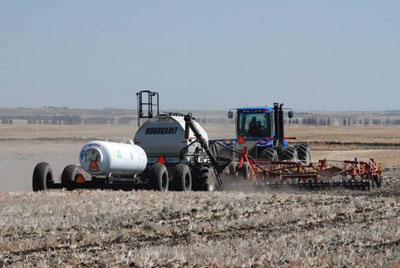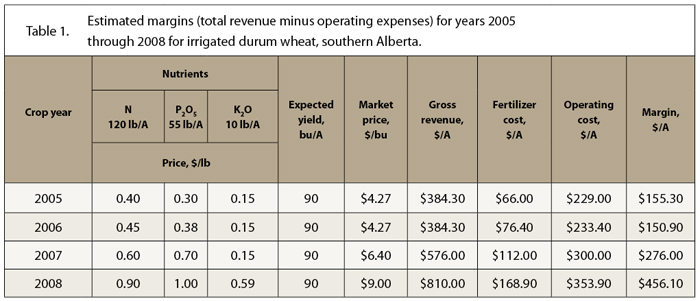
Features
Agronomy
Fertility and Nutrients
Food production and economics of fertilizer use
Most grain and oilseed producers are pleased to realize the recent increase in crop prices after many years of relatively low and at times depressed grain and oilseed prices.
March 3, 2009 By Tom Jensen*
Most grain and oilseed producers are pleased to realize the recent increase in crop prices after many years of relatively low and at times depressed grain and oilseed prices. There is an overall feeling of optimism in crop production. However, the accompanying increases in fertilizer prices have growers questioning whether or not the changes in crop and fertilizer prices relative to one another justify changes in fertilizer application rates.
 |
|
| Calculations indicate that optimum rates of fertilizer have changed very little despite higher fertilizer costs. |
A few calculations show that optimum rates of fertilizer have changed very little if at all, while the size of fertilizer expenditure has increased. Associated with the larger fertilizer expenditure is more up-front financing and much more valuable potential crop growing in the field. This combines to create an increased need for careful decision making. Growers can manage this increased need by doing the following.
- Have soil samples taken and analyzed for nutrient availability and adjust fertilizer rates on each individual field. Soil test laboratories are seeing an increase in fields being soil sampled.
- Time fertilizer applications to maximize crop utilization and minimize unwanted losses. Generally this may mean application near the time of planting or in split applications during the growing season for some crops.Place N fertilizers in the soil in bands to reduce losses compared to broadcast applications. Use appropriate starter fertilizer blends precision placed near or for some crops in the seed-row when planting.
- Consider using fertilizer forms or additives that can result in enhanced efficiency and /or reduced losses of applied nutrients. This may include use of controlled release fertilizers or addition of inhibitors that keep fertilizers in forms less susceptible
- to losses.
- Seek the advice of Certified Crop Advisers (CCAs) and crop consultants in making fertilizer decisions. Sound advice from an experienced CCA can help a grower determine whether or not there should be changes in fertilize rates. This is especially important when both grain and fertilizer prices change.
An excellent example of a crop planning tool used with farm customers was developed by Keith Mills, a CCA working for a retail grain and crop input company in Western Canada. He works with farm customers growing crops under both irrigated and rain-fed conditions in southern Alberta. His easy-to-use Basic Crop Planner is a spreadsheet program he uses with customers to estimate potential returns per acre for a number of different crops. His customers often use this tool to help them decide which crops to grow if they are considering changes in their crop rotations. The grower can quickly calculate margins per acre by entering realistic crop yields for their farm along with current area prices for crop inputs, including fertilizers, and prices expected for harvested crops.
 |
Keith Mills emphasizes that the yield and input price estimates entered need to be realistic for the area. The Basic Crop Planner is based on variable crop inputs and expected crop yields and current market prices, and does not include fixed costs as this can vary greatly from farm to farm depending on specific land ownership and rental conditions. Mills updates his crop planner each year with average crop prices and input costs for the area where he works. It can be modified by an individual customer especially for expected crop yields depending on specific field conditions, and if an alternate source for crop inputs at different prices is found.
It is interesting to compare information from a number of years for a specific crop and see how changes in crop input prices or operating costs and grain prices affect margin returns considering reducing their rates of fertilizer solely because of increases in fertilizer prices. However, when they saw what the margins were using current fertilizer and crop prices, fertilizer rates have in most cases remained similar to recent years and margins have increased. An example in Table 1 shows estimated returns over the years 2005, 2006, 2007 and 2008 for irrigated durum wheat.
Operating costs have increased and fertilizer inputs have increased more compared to most other crop inputs, such as herbicides and fuel. The fertilizer costs as a percentage of operating costs are 29 percent, 33 percent, 37 percent and 48 percent, respectively for the years 2005, 2006, 2007 and 2008. For example, if the years 2006 and 2008 are compared, fertilizer costs increased 121 percent, but margins increased 202 percent. Between the two years, every extra $1.00 of investment in fertilizer has been offset by $2.49 in increased margin per acre.
Fertilizer rates have remained similar over the past four years even though the portion of the operating costs from fertilizers has increased. Fortunately for growers, the return on fertilizer expenditures remains very positive and optimum economic fertilizer rates have remained similar to rates before the increases in both grain and fertilizer prices.
*Dr. Jensen is IPNI Northern Great Plains Region Director, located in Saskatoon, Saskatchewan, CanadaReprinted from Better Crops with Plant Food, with permission of International Plant Nutrition Institute (IPNI).